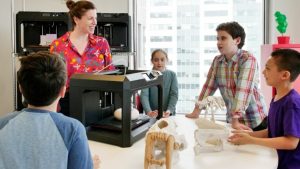3D printing has emerged as a transformative technology across various fields, from engineering and architecture to art and fashion. For students, learning 3D printing opens up a world of creativity and practical skills that are increasingly valuable in today’s job market. This guide will walk you through the basics of 3D printing and provide tips on how to get started.

Understanding 3D Printing
At its core, 3D printing is the process of creating a physical object from a digital model by building it layer by layer. The technology, also known as additive manufacturing, allows for the production of complex shapes and structures that would be difficult or impossible to achieve with traditional manufacturing methods.
There are several types of 3D printing technologies, but the most common for beginners are Fused Deposition Modeling (FDM) and Stereolithography (SLA). FDM printers use thermoplastic filaments, such as PLA or ABS, which are melted and extruded through a nozzle to build up the object. SLA printers, on the other hand, use a laser to cure liquid resin into solid layers, offering higher detail and smoother finishes.

Getting Started with 3D Printing
- Learn the Basics of 3D Design: Before you can start printing, you need a digital model to work from. This is typically created using Computer-Aided Design (CAD) software. Popular programs like Tinkercad, Fusion 360, and Blender are great places to start, each offering a range of tools to create 3D models from scratch. Tinkercad is particularly beginner-friendly, with an intuitive interface and plenty of tutorials.
- Choose the Right 3D Printer: As a student, budget is often a concern, so choosing an affordable and reliable 3D printer is important. FDM printers are generally less expensive and easier to maintain, making them a good choice for beginners. Some popular entry-level models include the Creality Ender 3 and Prusa Mini. If you’re looking for higher detail and are willing to invest a bit more, consider an SLA printer like the Anycubic Photon.
- Understand Materials and Filaments: The material you choose for printing will depend on your project’s needs. PLA is the most commonly used filament, known for its ease of use and biodegradability. ABS is another option, offering more durability but requiring a heated bed for better adhesion. For SLA printing, resin comes in different types, including standard, flexible, and clear, each suitable for different applications.
- Start with Simple Projects: As with any new skill, it’s best to start small. Begin with simple projects, such as keychains or small figurines, to get a feel for the process. This will help you understand how your printer works, how to adjust settings, and how different materials behave. Websites like Thingiverse offer thousands of free 3D models that you can download and print to practice.
- Troubleshooting and Learning Resources: Don’t be discouraged by failures—3D printing often involves a lot of trial and error. Common issues include poor bed adhesion, stringing, and warping. There are many online communities and forums where you can seek advice, such as Reddit’s 3D printing community or the 3D Printing Stack Exchange. Additionally, YouTube is a treasure trove of tutorials and troubleshooting guides.

Applications of 3D Printing for Students
3D printing is not just about making cool objects—it’s a tool that can enhance your learning in various subjects. In engineering, it allows you to prototype and test your designs. In art, it opens up new possibilities for sculpture and model-making. Even in biology, you can use 3D printing to create models of organs or molecules for study. The skills you develop in 3D printing will be highly valuable in many fields, from product design to medical research.

Learning 3D printing as a student is an exciting journey that combines creativity, technical skills, and problem-solving. By starting with the basics, choosing the right equipment, and embracing the learning process, you can unlock a powerful tool that will serve you well in your studies and future career. Whether you’re making prototypes for a class project or exploring new artistic avenues, 3D printing offers endless possibilities.










